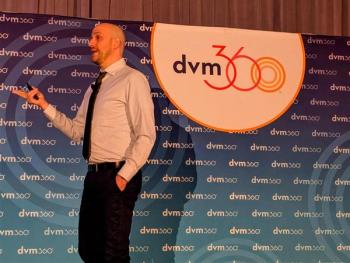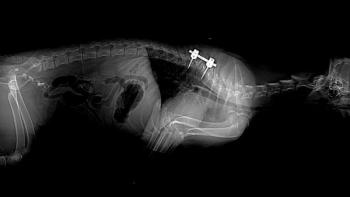
- dvm360 July 2022
- Volume 53
- Issue 7
Addressing multimodal pain management with 3 novel approaches
See how clinicians tackle pain management from new angles
On the frontiers of science, research, and medicine, new treatment modalities constantly emerge. When considering treatment options for multimodal pain management in small animals, clinicians should have the proper tools in their toolbox. Here are 3 techniques beginning to garner attention:
Fear Free techniques
Steve Dale, CABC, and Leilani Alvarez, DVM, DACVSMR, CVA, CCRT, presented their session “Pain Can Be Heeled: Multimodal Now Includes Dog Training”1 at the 2022 Fetch dvm360® Conference in Charlotte, North Carolina. The pair drew parallels to human medicine research showing how stress, anxiety, depression, and other negative moods can increase the perception of pain.2 In studies examining chronic lower back pain, total hip replacement, and total knee arthroplasty, fear and anxiety surrounding pain worsened outcomes in terms of pain perception and function.2,3 Conversely, they said, a positive outlook led to lower levels of pain and disability in one study.4 Results of another study showed a significant reduction in pain for 12 months when antidepressants were combined with a pain management plan.5
The presenters said this evidence suggests a link between state of mind and pain perception, pointing to cognitive strategies for pain management in humans as a guideline for reducing fear, stress, and anxiety in animal patients. They recommended investigating Fear Free Certification, a program that educates veterinary professionals on techniques for preventing and alleviating negative emotions in their patients. The goal is to reduce stress, anxiety, and fear for the pet as part of a multimodal approach to pain management.
2. Behavioral training
Dale and Alvarez explained that behavior can lead to chronic soft tissue injuries. “I see, particularly in small dogs, jumping on and off the furniture all day long…. They’re landing on slippery surfaces, breaking down that carpal cartilage, and it presents to me as carpal hyperextension injuries,” said Alvarez.
The pet may recover from or prevent such injuries by undergoing customized behavioral training designed to eliminate or modify the offending behavior. The patient may achieve this with in-home or virtual visits from an animal behavioralist or a care plan from a veterinarian. “We want to not only prevent the injury from recurring [but also] prevent new injury as well,” said Dale.
3. Hyperbaric oxygen therapy
For years, physicians have widely used hyperbaric oxygen therapy (HBO) inhumanmedicinetotreat patients with many conditions including decompression sickness, serious infections, nonhealing wounds, and anemia.Its use in veterinary medicine is relatively new, with research still emerging andalimited number ofveterinaryhospitalsin the United States employing the modality.
During HBO, the animal is placed safely and comfortably in a chamber with an atmosphere composed of 100% oxygen and a pressure 1.5 to 3 times above normal atmospheric pressure, thereby allowing more oxygen to the tissues throughout their body. According to the University of Florida College of Veterinary Medicine Small Animal Hospital, this treatment generally results in “reduction in swelling, stimulation of new blood vessel formation into the healing/swollen tissue, a reduction in pressure caused by head or spinal cord injuries, improved [wound] healing, and improved infection control.”6 Although currently limited to a small number of veterinary hospitals, HBO presents a possible new modality for pain management on the horizon pending further research.
References
- Dale S, Alvarez L. Pain can be heeled: multimodal now includes dog training. Presented at: Fetch dvm360® Conference; April 22-24, 2022; Charlotte, NC.
- Koechlin H, Coakley R, Schechter N, Werner C, Kossowsky J. The role of emotion regulation in chronic pain: a systematic literature review. J Psychosom Res. 2018;107:38-45. doi:10.1016/j.jpsychores.2018.02.002
- Sorel JC, Veltman ES, Honig A, Poolman RW. The influence of preoperative psychological distress on pain and function after total knee arthroplasty: a systematic review and meta-analysis. Bone Joint J. 2019;101-B(1):7-14. doi:10.1302/0301-620X.101B1.BJJ-2018-0672.R1
- Martinez-Calderon J, Zamora-Campos C, Navarro-Ledesma S, Luque-Suarez A. The role of self-efficacy on the prognosis of chronic musculoskeletal pain: a systematic review. J Pain. 2018;19(1):10-34. doi:10.1016/j.jpain.2017.08.008
- Kroenke K, Bair MJ, Damush TM, et al. Optimized antidepressant therapy and pain self-management in primary care patients with depression and musculoskeletal pain: a randomized controlled trial. JAMA. 2009;301(20):2099-2110. doi:10.1001/jama.2009.723
- Hyperbaric oxygen chamber. University of Florida Small Animal Hospital. Accessed June 15, 2022. https://smallanimal.vethospital.ufl.edu/clinical-services/integrative-medicine-services/hyperbaric-oxygen-chamber
Articles in this issue
over 3 years ago
Z is for zebras and other dental surprisesover 3 years ago
Practice ownership perksover 3 years ago
3 steps to protect your practice from ransomwareover 3 years ago
Colic surgery delivers a painful reminderover 3 years ago
Hiring isn't all about moneyover 3 years ago
Dermatology image quizover 3 years ago
Protecting adopted pets from heartworm diseaseover 3 years ago
The A — Z on ADA complianceNewsletter
From exam room tips to practice management insights, get trusted veterinary news delivered straight to your inbox—subscribe to dvm360.






